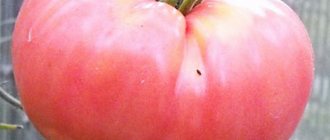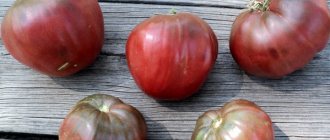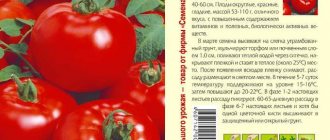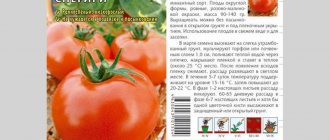Vegetable growers who have been planting the Easter Egg tomato for several years note that it bears fruit well in any soil, and its fruits do not become smaller even by the end of the season. For these qualities and for its beauty, the variety is becoming increasingly in demand among summer residents. The marketable appearance makes the Easter egg attractive for growing in farm enterprises.
| Height | Landing location | Ripening time | Fruit color | Fruit size | Origin | Fruit shape |
| Tall | Greenhouse, Open ground | Mid-early | Bicolor | Small | Variety | Plum-shaped or oval |
Description of the tomato variety Easter egg
The Easter egg tomato appeared on the market relatively recently, but almost immediately became one of the most popular. It got its name for its original shape and unusual color, which is really similar to eggs painted for the Great Holiday.
But gardeners grow it not only because of its appearance. The taste of the tomato is much more important. It is rich, sweet and sour.
Note! Tomato Easter egg is very popular among those who watch their figure. Even one fruit is enough for a snack.
The variety grows on any soil and produces crops throughout the season. The best indicators are in the south and in the middle zone. In the north it can also be grown, but only in closed beds.
Features of the variety
The tomato is an early ripening one. It is suitable for growing in the southern and middle zones.
In the south it is grown in open ground, and in the middle zone greenhouses are more often used (but they are also grown in open ground).
Early ripening tomato varieties are most suitable for growing in regions where summers are short. In the southern regions, the long growing season makes it possible to grow not only early-ripening varieties, but also late-ripening ones, which ripen 115-120 days after germination.
The bush is tall, usually up to 1.7-1.8 m, but sometimes reaches 2 m.
Due to the high growth of the stem and abundant fruiting (5-7 fruits in one cluster), the tomato needs a garter.
Distinctive features
The Easter Egg variety is not as popular as cherry, but thanks to its advantages it has every chance of becoming a favorite in the cocktail line.
Description of the bush
The Easter Egg tomato bush is a vigorous grower. When grown in open ground, it can reach 1.7 m in height. In the greenhouse there are also two-meter specimens. Such parameters indicate the need for tying and pinching the tomato.
The fruits ripen in clusters of 6 pieces. The hybrid bears fruit until frost.
Description of fruits
The fruits of the Easter Egg tomato variety are classified as cocktail type. This is partly due to their small size and taste characteristics.
- fruits grow in clusters of 5-6 pieces;
- fruit weight - 70-90 g;
- bright red color with golden stripes;
- ovoid shape;
- taste sweet and sour;
- The pulp is juicy, with a large number of seed chambers.
The use of the fruits of the Easter Egg variety depends on the preferences of the gardener himself. Tomatoes are perfect for both fresh consumption and for preparing various dishes. Preservation of such vegetables is especially popular.
The thick skin of the fruit does not crack, and therefore they tolerate transportation well and are stored for a long time.
Taste
The taste characteristics are the best. The tomato is quite sweet, but has a slight sourness and a subtle fruity flavor. Despite its high density, the skin is not at all tough.
Another advantage of the variety is its pronounced pleasant aroma.
Why was it bred?
Tomatoes of the Easter Egg variety are mainly consumed fresh. Their pulp is sweet, very aromatic, with a slight sourness. If desired, these tomatoes can also be used for canning. The fruit sizes are most suitable for this, on average - about 50-90 g. In addition, their skin is very dense, so they do not crack. And thanks to their unusual color, tomatoes in jars look very attractive and original.
The Easter Egg variety can be grown, including for sale. Thanks to their thick skin, the fruits of these tomatoes do not crack and can withstand long-term transportation. Tomatoes are stored for a long time, which is also undoubtedly a plus.
Reviews from gardeners
The Easter Egg variety is one of the best for growing in the southern regions. In the middle climate zone, to obtain a good harvest, the hybrid must be grown in a greenhouse.
People familiar with this culture talk about changes in the shape of the fruit and their taste during different periods of the growing season. The first tomatoes are larger. They are juicy and moderately sweet. These fruits are perfect for fresh consumption. The late harvest, harvested in early autumn, is smaller and sweeter. These tomatoes are suitable for canning and making juices.
Characteristics of tomatoes Easter egg
The Easter Egg variety is a cocktail variety. This category of tomatoes appeared not so long ago. The main characteristic feature is the unusual shape of the fruit, which may resemble pears, plums, peppers, etc. The color of tomatoes in this category will also please the eye - you can find tomatoes from soft yellow, greenish, up to rich red. The collected fruits will have a small weight - about 60 grams. They have a very strong aroma and excellent taste. So, these tomatoes contain a large amount of sugar and have a slight sourness.
Thanks to its characteristics, the Easter egg tomato can become a decoration for any table - both everyday and festive. The fruits are mostly used for fresh consumption, but are also suitable for canning.
On a note! Breeders are constantly working to improve the taste, shape and color of these tomatoes. Many summer residents have already become interested in the variety and began to grow them in their gardens.
Description of Tomato Easter Egg:
- Belongs to the indeterminate type;
- In terms of fruiting time – mid-early. After the first shoots appear, the harvest can be harvested after 3-4 months;
- It can grow in open ground conditions, but in the Moscow region it is grown exclusively in greenhouses;
- It has rather tall, spreading bushes that can reach 2 m in height;
- This tomato must be pinched, pinched, and systematically tied up;
- On the bushes you need to form 2-3 stems;
- The first ovaries are collected in inflorescences of brushes, each of which will grow about 6 tomatoes;
- Fruits that are ripe are egg-shaped. They are dense, fleshy, the color is red and yellow, the skin is dense and does not crack.
The fruits of the Easter egg tomato really look very much like painted eggs. The yield of the variety is quite extended. The fruits that ripen the latest will be even smaller than the first ones, but their taste will be sweeter.
What are cocktail tomatoes?
You may be interested in: Tomato “Amur Tiger”: description of the variety, reviews
The fruits of the varieties of this group are very similar to the cherry tomatoes already well known to summer residents. Tomatoes are also collected in clusters of different sizes and are characterized by high decorative qualities. Cocktail tomatoes differ from cherry tomatoes mainly only in size: they are slightly larger. On each bunch of tomatoes of this variety can form from 5 to 20 fruits with a bright, eye-catching color.
The yield of cocktail varieties is quite good. In any case, they are superior to Cherry in this regard. The advantages of such tomatoes, among other things, include the simultaneous ripening of fruits on the cluster. Therefore, harvesting is convenient.
You may be interested in: Mamluk cucumber: description with photo
In most cases, cocktail tomatoes are large in size; the predominant number of varieties can be described as “tall”. But sometimes domestic summer residents also grow determinate tomatoes of this variety. Breeders have developed varieties of cocktail tomatoes, both early, mid-season and late.
Sowing seeds for seedlings
This tomato variety is intended primarily for cultivation in open ground. However, if desired, of course, you can grow it indoors. As some gardeners note, in greenhouses and greenhouses, Easter egg ovaries appear without any additional action. That is, this variety belongs to the group of self-pollinating ones.
In the description of tomatoes of the Easter Egg variety and reviews of summer residents about it, you can find information that this is a very unpretentious and productive plant. Growing this crop in a suburban area will not be difficult. The technology for cultivating these tomatoes is practically no different from the method of growing ordinary tomatoes. Summer residents most often sow Easter egg seeds for seedlings in March. The soil in the boxes is thoroughly spilled with boiling water for disinfection a day before planting. The seeds are placed in grooves 1 cm deep in 2 cm increments.
Next, the box is covered with film and placed in a dark, warm place. As soon as the sprouts hatch, the seedlings are transferred to the windowsill of a south or east window. After the first true leaf appears, picking is done (preferably into separate cups).
Easter egg tomatoes are planted in open ground at the end of May. A large amount of organic matter is pre-mixed into the soil. The bushes are planted in holes according to the pattern 40x60 or 50x60 cm. To prevent the seedlings from being damaged by the wind, each plant is tied to a support.
Optimal timing
Sowing is carried out on March 1–10. At such a time frame, the seedlings can be moved to a permanent place in early May. The calculation is carried out based on the growth time of the seedlings - usually they are ready for transplantation at the age of 55–60 days.
Seed preparation
The seeds are soaked for 20 minutes in a 1% solution of potassium permanganate, then washed and immersed in any growth stimulator. This can be aloe juice diluted 1 to 1 with water, a solution of honey (1 teaspoon per glass of warm water) or special formulations: “Epin”, “Gumate”, “Energen”.
Features of cultivation
Unnecessary shoots must be removed
The Easter egg hybrid is a mid-early hybrid. After sowing the seeds, the harvest waits from 90 to 110 days. Growing seedlings is not difficult. Seeds are sown in small pots or trays with fertile soil. Before emergence, the containers are covered with polyethylene and placed in a warm place. With the emergence of seedlings, the seedlings are placed in the sun.
Transplantation into a greenhouse is carried out in May, and into open ground - no earlier than the first ten days of June. The earth, like the air, must be well warmed up: sudden cold snaps can destroy plants.
- For planting, light types of soil with preliminary drainage are used.
- Seedlings are planted in pre-disinfected soil. To do this, use a solution of potassium permanganate.
- The bushes are grown in formed beds, the width of which is 80 cm and the height is 30 cm.
Bushes are dug in parallel or in a checkerboard pattern. For growing crops, this feature does not matter. Since the bushes are vigorous, at the same time as planting, supports for the garter are installed. It is not recommended to do this later, as this work can lead to disruption of the root system of tomatoes.
In addition to tying, pruning is carried out. Removing leaves and unnecessary shoots will allow the plant to concentrate its energy on growing fruit.
Caring for seedlings deserves special attention. Watering should be moderate: excess moisture leads to root rot.
The first procedure is carried out 30 days after planting. Only warm, settled water is used, so before planting, care should be taken to install an open container for storing water near the planned growing site.
Regular weeding and fertilizers contribute to better yields. Fertilizing is often done with complex mineral compounds, although this variety of tomatoes is not picky about the type of fertilizer. The main thing is not to apply nitrogen fertilizers during the flowering period.
Technology of planting seedlings
To plant seedlings in open ground or in a greenhouse, follow the indicated technology.
- Moisten the soil in containers with seedlings.
- Dig holes. The distance between bushes should be 50 cm.
- Remove the seedlings from the boxes and move them into the holes.
- Fill the holes with soil.
- Water the seedlings.
Seedlings grown and planted according to the above rules will quickly take root and begin to grow.
Important! When planting, be careful not to damage the roots of the plant. The rooting of the bush depends on the condition of the root system.
Planting and care
For those wishing to grow tomatoes, the seeds are sold unprocessed, as it is a variety and not a hybrid. The gardener must provide the seed with protection from rot and mold. To do this, the seeds are soaked for 20 minutes in a 1% solution of potassium permanganate, then washed and immersed in any growth stimulator (Silk, Epin, aloe juice, Humate, succinic acid). Seeds are sown without waiting for them to peck. Plants treated with the stimulant sprout quickly, do not suffer from blackleg, and are resistant to pulling.
Care in open ground or a greenhouse consists of watering, pinching and two feedings:
- the first - during mass flowering;
- the second - during mass setting and filling of fruits.
For fertilizing, use Kemira for tomatoes fertilizer or any other complex fertilizer that includes macro- and microelements.
Tomato care Easter egg
This variety requires pinching - cut off the side shoots and form a bush with 2 stems.
Care includes regular but moderate watering as the soil dries (once every 1-2 weeks). If possible, it is better to use drip or underground irrigation with warm, settled water. You can add a little ash to the water.
To fertilize the soil, it is better to use complex compounds.
Another mandatory care measure is regular loosening and weeding. This is done as needed - as soon as a crust forms on the surface of the soil or the first weeds appear.
It is also recommended to mulch the soil in the garden bed with dried grass.
Watering
When watering, follow these rules:
- water is not colder than +21°C;
- 5 liters for one bush;
- watering as the soil dries out, every 3 days;
- You need to irrigate the soil using a watering can without touching the tops;
- watering time - preferably in the morning before solar activity begins, but it is also possible in the evening.
Top dressing
Tomato Easter Eggs requires fertilizing for the normal development of bushes. They are applied in two ways: foliar spraying and introduction into the soil.
There are different schemes for applying fertilizing. Gardeners usually fertilize tomatoes based on a schedule that suits them. The minimum number of feedings during the growing season is three. Schemes for 4 feedings are also offered. However, bushes respond best to fertilization every 2 weeks.
Both mineral fertilizers and organic matter are suitable for tomatoes. Many farmers choose the organo-mineral preparation “Ideal”. It consists of four components: humic substances, nitrogen, phosphorus and potassium. Organic matter, such as bird droppings, is also popular.
Stepping and bush formation
Tomatoes Easter eggs need pinching. The stepsons need to be carefully broken out and not pulled out. Their removal has a beneficial effect on the harvest. Also, for the development of fruits, the bush should be shaped. In this case, it is better to leave 2 main trunks. To prevent the shoots from bending under the weight of the fruit, they need to be tied up. You can use a trellis or a stick 2 m high. As they grow, the branches are tied with strips of fabric.
Weeding the soil
Weeds should be removed as they appear. It is convenient to weed the beds when loosening. It is best to loosen the soil at the same time as watering.
Important! To avoid rotting, use synthetic materials for tying.
Harvesting and application
The Easter egg usually begins to fructify at the end of July. Ripening in clusters of 5-7 pieces continues until the first frost. Thus, for about a month, fresh tomatoes can be served directly from the garden to the table served for a buffet or cocktail. The excellent taste of these festively bright tomatoes is noted by almost everyone who has had the chance to try them: dense, meaty, sweet with a slight sourness and a specific tomato aroma. Many people note that by the end of the season the fruits become smaller and sweeter.
Interesting . Easter egg can rightfully be called a universal variety due to its compactness, decorativeness and keeping quality.
Small tomatoes are suitable for whole-fruit canning. The dense skin is resistant to cracking and mechanical damage, so the fruits tolerate transportation and long-term storage in a cool and dry place. But in terms of juice or paste production, the Easter egg is inferior to large-fruited tomato varieties.
Diseases and pests of the variety
The Easter eggs variety is resistant to diseases and pests. If fungal diseases, plaque, or rot are nevertheless noticed, use fungicides, for example, Topaz. To control insects, use insecticides such as Actellik.
To prevent diseases, vegetable growers often spray bushes with Bordeaux mixture. Ash infusion is offered from natural preparations. For this, 2 tbsp. l. crushed charcoal, pour 2 liters of water. After 2 days, the solution can be sprayed on the plants.










